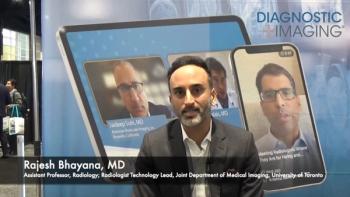
Wireless pushes PACS images to PDAs
Experts expect the use of wireless technology in healthcare to grow dramatically over the next few years, so much so that you could find your PDA linked to your PACS. While less than 1% of physicians in the U.S. use handheld wireless devices for
Experts expect the use of wireless technology in healthcare to grow dramatically over the next few years, so much so that you could find your PDA linked to your PACS.
While less than 1% of physicians in the U.S. use handheld wireless devices for transactional purposes, a report from W.R. Hambrecht & Co. suggests that figure may jump to 20% by 2004. This increase speaks to the appeal of wireless technology to all sectors of healthcare, in which a life-and-death workflow demands access to the right information at the right time.
Wireless technology could eventually appeal even to the digital imaging community, where PACS may one day push images to referring physicians carrying PDAs.
"Wireless applications in the imaging domain present various technical challenges, so their adoption has been limited," said Dr. Saji Salem, head of the HIPAA Solutions Group at Silverline Technologies, an international e-business and integration services firm based in Piscataway, NJ. "But physicians would love to use a mobile device to order a CT scan and then be alerted when the image is ready."
Physicians could even view the image while on the move by accessing the electronic patient record on a mobile device that displays digital images stored on the hospital's server, he said.
"The major challenge in making these applications work relates to availability of bandwidth, or rather the lack of it," Salem said.
In the wired world, 100-Mbps Ethernet connections have become common, especially as backbones for networks or to push multimegabyte graphics files through communications pipelines. The theoretical data throughput limit for today's wireless local area networks is 11 Mbps.
But environmental factors, such as the distance between portable computers and network access points, restrict wireless networks to about 7 Mbps, Salem said. High bandwidth is not considered realistic in the near future in the mobile wireless world. Despite fast GPRS speeds in theory, actual speeds of live wireless networks are estimated to be only 14 to 28 Kbps.
Realizing the benefits that wireless computing can bring to the healthcare enterprise, vendors have nevertheless come up with a variety of products - critical care monitoring, e-prescriptions, scheduling, electronic medical record, lab - aimed at improving patient care.
The response from healthcare providers has been mixed. Some early adopters have implemented a host of wireless applications, but most physicians have approached the wireless world with caution.
The skepticism is valid. A number of concerns need to be addressed before healthcare embraces wireless technologies with much passion. Screen size is one.
"The small screen size of the mobile phone makes usability an issue at the moment," Salem said. "Phones built into PDAs, and vice versa, are already on the market and will find wider acceptance as benefits from such integrated devices become common."
Newsletter
Stay at the forefront of radiology with the Diagnostic Imaging newsletter, delivering the latest news, clinical insights, and imaging advancements for today’s radiologists.




























